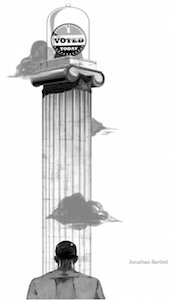
In 2014, the first post-Shelby election, thousands were turned away by new restrictions in states like Texas and North Carolina. A 2014 study by the Government Accountability Office found that voter ID laws in Kansas and Tennessee reduced turnout by 2 to 3 percent during the 2012 election, enough to swing a close vote, with the highest drop-off among young, black and newly registered voters.
This could be a disturbing preview for 2016, which will be the first presidential contest in 50 years where voters cannot rely on the full protections of the act. New restrictions will be in place in up to 15 states, which account for as many as 162 electoral votes, including crucial swing states like Ohio, Wisconsin and Virginia.
The act, signed 50 years ago today, was the crowning achievement of the civil rights movement. It swept aside longstanding practices that disenfranchised voters, and prevented new ones from emerging: Between 1965 and 2013 the Justice Department and federal courts blocked more than 3,000 discriminatory voting changes. But it is precisely that capacity, known as preclearance, that the Roberts court invalidated.
The backlash to the law was as immediate as its progress. Southern states quickly challenged its constitutionality, and several changed their election laws to stop newly registered black voters and candidates from winning elected office.
The battle soon shifted from registration to representation, from the right to vote to the value of that vote. In 1969, the Supreme Court declared that the federal government had the power to block the “second-generation” voting restrictions adopted by Southern states to subvert the growing minority vote, like gerrymandering, consolidating smaller black areas with larger white ones and switching from district to countywide elections, where the white majority remained in control.
But as the reach of the law expanded, so did the opposition to it. When minority candidates began to be elected in large numbers in the 1970s and 1980s, “colorblindness” replaced states’ rights as a more respectable rallying cry for opponents. They held that the law should only block obstacles to voter registration, like literacy tests, rather than outlawing electoral schemes that prevented minority voters from winning office.
In the 1980s, resistance to the civil rights laws of the 1960s became a defining cause for ambitious young conservatives like John Roberts, who wrote dozens of memos criticizing the Voting Rights Act while serving in the Reagan Justice Department. He believed the act should prohibit only intentional discrimination in voting, which was nearly impossible to prove. He lost that fight when Congress overwhelmingly reauthorized the act in 1982, but the Reagan administration appointed a generation of judges who approached it with deep skepticism.
The backlash entered a new phase after the 2000 election, when a botched voter purge in Florida, while Jeb Bush was governor, disproportionately prevented African-Americans from voting and helped George W. Bush win the White House. The Bush administration reoriented the Justice Department, prioritizing prosecutions of voter fraud over investigations into voter disenfranchisement.
The push to make it harder to vote escalated after the Tea Party’s triumph in the 2010 elections, when half the states, nearly all of them under Republican control, passed new voting restrictions, which disproportionately targeted the core of President Obama’s coalition, particularly minority voters. The voting changes were subtler than those of the 1960s, camouflaging efforts to deter voting with laws that rarely invoked race, introduced with equal fervor in North and South alike.
Many of these laws were blocked in court during the 2012 election and helped inspire a backlash by minority voters. That year, for the first time in a presidential election, the percentage of blacks who turned out to vote exceeded that of whites.
Then came Shelby County. Laws that were previously stopped under the act, like Texas’ strict voter ID law, immediately went into effect, while new states rushed to pass tougher voting restrictions. (On Wednesday the Fifth Circuit Court of Appeals largely upheld a lower-court ruling that struck down the Texas law.) A month after the Shelby County decision, North Carolina passed a sweeping restructuring of its election system, repealing or curtailing nearly every reform in the state that made it easier to vote.
The Justice Department and civil rights groups are challenging the new law in federal court. North Carolina is making the familiar argument that the lawsuit amounts to “the equivalent of election law affirmative action.”
But even if the plaintiffs win, that’s just one law, in one state. The voting rights landscape today most closely resembles the period before 1965, when the blight of voting discrimination could be challenged only on a torturous case-by-case basis.
What can be done? The Voting Rights Advancement Act of 2015, introduced in Congress in June, would compel states with a recent history of voting discrimination to once again clear election changes with the federal government and would require approval for specific measures that often target minority voters today. But the bill hasn’t gone anywhere. On the 50th anniversary of the Voting Rights Act, Congress won’t even schedule a hearing.
___
Ari Berman is a political correspondent for The Nation and the author of “Give Us the Ballot: The Modern Struggle for Voting Rights in America.”